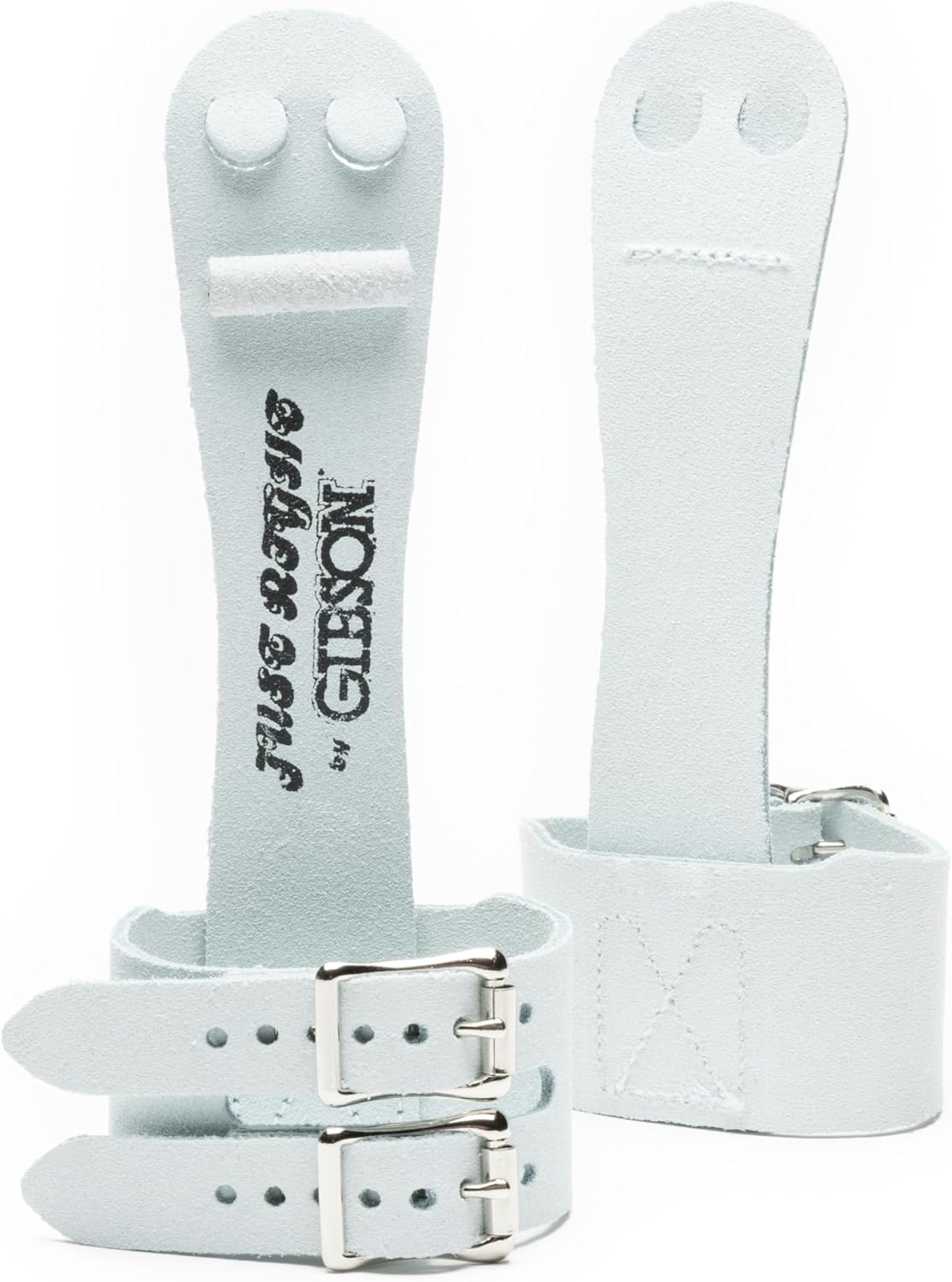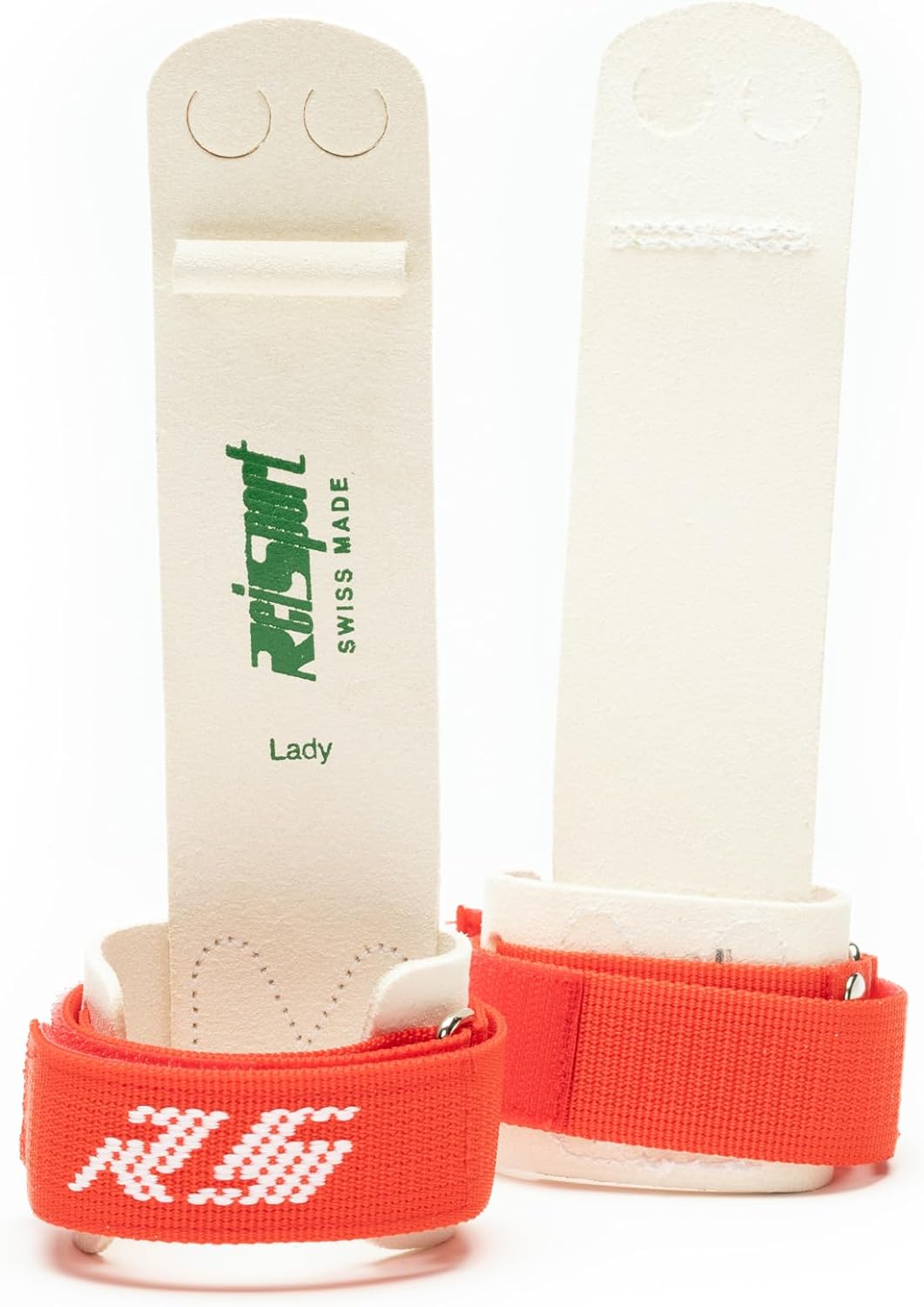
Finding the Best Gymnastics Grips can feel like navigating through a maze of endless options, but fear not, this comprehensive buyer’s guide is your beacon through the confusion. In this guide, we’ll explore the top picks that are popular with gymnasts everywhere.
Features

Gibson

Reisport

Ninja Sports
Dowell
Shape
Skinny
Straight
Curved
Buckle or Hook and Loop
Buckle
Hook and Loop
Hook and Loop
Amazon Rating
What Are Gymnastics Grips?
One of the essential pieces of kit found in any gym bag are grips which are designed to reduce the pain and injury to the hands of gymnasts.
Grips are used primarily on Uneven Bars (women) and the High Bar (men). They can also be used by male gymnasts on the rings and parallel bars. Swinging on these types of apparatus can cause blisters, tears and major discomfort to the hands.
What Are Grips Made Of?
Grips are handguards made of leather that cover the palm of a gymnast’s hand. They have holes that fit over the fingers and a strap that wraps around the wrist. The leather used in grips is durable, and the finger holes are designed to give the gymnast a better grip on the apparatus.

Why Do Gymnasts Wear Grips?
Grips provide several benefits to gymnasts. First, they help prevent rips, blisters and calluses that can be caused by repetitive use of the hands on the bars. The friction between the bar and the skin can’t be avoided as gymnasts swing around the bars which would be impossible unless the hands and wrists moved around the bar as well.
Second, grips provide a better grip on the apparatus, reducing the chances of slipping or losing control during a routine. Finally, grips offer added support to the wrist, which is essential in gymnastics, especially during high-impact releases and catches.

Types of Grips for Gymnasts
There are slightly different types of grip for male and female gymnasts.
For female gymnasts, there are Dowel grips and non-Dowel grips. The Dowel is a small rod that goes across the fingers and provides more grip for advanced gymnasts doing giants and other harder skills.
Younger female gymnasts won’t need this and usually use non-Dowel grips.

There are also variations in the thickness of the leather with older more advanced gymnasts needing thicker grips compared to the younger less experienced gymnasts.
When Should a Gymnast Get Grips?
Grips are usually introduced when a competitive gymnast reaches level 4 or level 5 in the USA Gymnastics program. However, this can vary depending on the gym and the coach.
Gymnasts should get grips when they start performing more complex moves on the bars that require a better grip and more wrist support. Swings tend to be one of the first skills that starts to cause blisters or calluses on the hands and this is often a good point to invest in grips.

Chalk is used to reduce the friction and sweat that builds up on a gymnast’s skin but chalk alone will not reduce the discomfort to the hands when practicing a lot of swings.
Before getting grips, it’s essential to consult with a coach to ensure that the gymnast is ready to use them. Recreational-level gymnasts tend not to use grips as they are not performing as many repetitions or advanced-level skills.
Not all gymnasts like wearing grips as they can be uncomfortable and some gymnasts prefer the feel of the bar without them. It is a matter of personal choice and there are no rules stating that they can or can’t be worn unless a specific club or coach makes that a policy in their training sessions.
Shapes of Gymnastics Grips
Grips come in three different shapes – Skinny, Straight or curved.

- Skinny Grips allow the gymnast to feel more of the bar. The Nastia Luikin Big Swinger Double Buckle Grips pictured above are Skinny Grips.
- Straight Grips cover more of the hand compared to Skinny Grips. The Nastia Luikin Russian Heritage Grip follows this type of design.
- Curved Grips such as the Gibson Rainbow Grips are somewhere in between Skinny and Straight in terms of coverage.
Buckle v Hook and Loop Grips

Grips are fastened around the wrist using either a buckle or hook and loop. It’s down to personal preference but the table below show generally who chooses which option.
| Level | Best Type of Grip |
| Beginners / Mid Level | Hook and Loop |
| Advanced | Buckle |
| Easier to adjust | Hook and Loop |
| Need more wrist support | Buckle |
Things to Consider When Buying Grips
Before you make a purchase check the following features:
- Dowel or Non-Dowel
- Shape of the Dowel (Straight, Curved or Skinny)
- Hook and Loop or Buckle
Also check the size by measuring the gymnasts hand. Brands can size slightly different to each other so be sure to check the relevant sizing guide.
You will usually need to measure from the tip of the middle finger to the bottom of the palm.

Best Brands for Gymnastics Grips
There are several popular brands of gymnastics grips available in the market. Some of the most popular ones are:
Each brand offers grips in different sizes and styles, and it’s essential to find the one that fits the gymnast’s hand comfortably.
Conclusion
In conclusion, grips are an essential piece of equipment for artistic gymnasts when they reach more advanced levels. They protect the hands, provide a better grip on the apparatus, and offer added wrist support.
The invention of grips has revolutionized the sport of gymnastics and has helped gymnasts perform more complex moves safely. When considering getting grips, it’s crucial to consult with a coach or trainer to ensure that the gymnast is ready.
FAQs
When did gymnasts start using grips?
Grips were invented in the 1960s by a gymnast named Dowell Johnson. He wanted to create a piece of equipment that would protect gymnasts’ hands and provide better grip while performing on the uneven bars. Johnson’s invention became successful during the 1960s and 70s and are now used by gymnasts all over the world.
How do you break in gymnastics grips fast?
Grips are made from leather which needs to be softened to get the best performance from them. With your new grips first roll the grip around the dowel down to the base. Then repeat with the dowel facing away from you. Repeat several times and then start using the grips for basic skills such as tap swings or pull overs.
How do I know if my gymnastics grips fit?
At first your new grips will feel tight until they have been broken in – you shouldn’t be able to fully extend your hand. Eventually the grip should cover the middle three fingers until the tips.
Are hook and loop or buckle grips better?
Hook and loop or buckle grips are a matter of personal preference. Generally beginners opt for hook and loop because they are simpler to get on and can be adjusted easily. More advanced gymnasts tend to use buckle grips as they are more secure and have less chance of coming undone halfway through a bar routine!
- How To Get Over a Mental Block In Gymnastics: A Complete Guide
 Gymnastics is a sport that requires not only physical strength and skill but also mental strength. When a gymnast feels like they cannot attempt a… Read more: How To Get Over a Mental Block In Gymnastics: A Complete Guide
Gymnastics is a sport that requires not only physical strength and skill but also mental strength. When a gymnast feels like they cannot attempt a… Read more: How To Get Over a Mental Block In Gymnastics: A Complete Guide - Find The Best Leotard For Girls (Guide)
 Finding an ideal leotard for girls isn’t just about picking a dazzling design that sparkles (although it does help!). The leotard has to fit perfectly,… Read more: Find The Best Leotard For Girls (Guide)
Finding an ideal leotard for girls isn’t just about picking a dazzling design that sparkles (although it does help!). The leotard has to fit perfectly,… Read more: Find The Best Leotard For Girls (Guide) - The Best Gymnastics Shorts (Our Top Picks)
 The best gymnastics shorts are designed to be worn over the top of a leotard providing additional coverage around the upper legs, whilst allowing gymnasts… Read more: The Best Gymnastics Shorts (Our Top Picks)
The best gymnastics shorts are designed to be worn over the top of a leotard providing additional coverage around the upper legs, whilst allowing gymnasts… Read more: The Best Gymnastics Shorts (Our Top Picks) - Decathlon Leotards – Are They Any Good?
 If you’re in the market for a new leotard, you may be wondering if Decathlon leotards are any good considering the low cost of their… Read more: Decathlon Leotards – Are They Any Good?
If you’re in the market for a new leotard, you may be wondering if Decathlon leotards are any good considering the low cost of their… Read more: Decathlon Leotards – Are They Any Good? - A Complete Guide to Gymnastics Hand Rips
 Are you tired of dealing with painful gymnastics rips on your hands from training? Look no further – this article offers a comprehensive approach to… Read more: A Complete Guide to Gymnastics Hand Rips
Are you tired of dealing with painful gymnastics rips on your hands from training? Look no further – this article offers a comprehensive approach to… Read more: A Complete Guide to Gymnastics Hand Rips - Is Gymnastics Dangerous? (Facts and Comparisons)
 Gymnastics is acknowledged as a highly technical and physically demanding sport. It inherently carries a risk of injury, which is why most coaches and clubs… Read more: Is Gymnastics Dangerous? (Facts and Comparisons)
Gymnastics is acknowledged as a highly technical and physically demanding sport. It inherently carries a risk of injury, which is why most coaches and clubs… Read more: Is Gymnastics Dangerous? (Facts and Comparisons)
